
The Lunar Society of Birmingham was a British dinner club and informal learned society of prominent figures in the Midlands Enlightenment, including industrialists, natural philosophers and intellectuals, who met regularly between 1765 and 1813 in Birmingham. At first called the Lunar Circle, "Lunar Society" became the formal name by 1775. The name arose because the society would meet during the full moon, as the extra light made the journey home easier and safer in the absence of street lighting. The members cheerfully referred to themselves as "lunaticks", a pun on lunatics. Venues included Erasmus Darwin's home in Lichfield, Matthew Boulton's home, Soho House, Bowbridge House in Derbyshire, and Great Barr Hall.

A factory, manufacturing plant or a production plant is an industrial site, often a complex consisting of several buildings filled with machinery, where workers manufacture items or operate machines which process each item into another. They are a critical part of modern economic production, with the majority of the world's goods being created or processed within factories.

Matthew Boulton was an English manufacturer and business partner of Scottish engineer James Watt. In the final quarter of the 18th century, the partnership installed hundreds of Boulton & Watt steam engines, which were a great advance on the state of the art, making possible the mechanisation of factories and mills. Boulton applied modern techniques to the minting of coins, striking millions of pieces for Britain and other countries, and supplying the Royal Mint with up-to-date equipment.

A mint is an industrial facility which manufactures coins that can be used as currency.
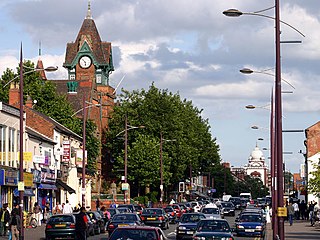
Handsworth is a suburban town and also an inner-city, urban area of northwest Birmingham in the West Midlands. Historically in Staffordshire, Handsworth lies just outside Birmingham City Centre.

The Soho Manufactory was an early factory which pioneered mass production on the assembly line principle, in Soho, Birmingham, England, at the beginning of the Industrial Revolution. It operated from 1766–1848 and was demolished in 1853.
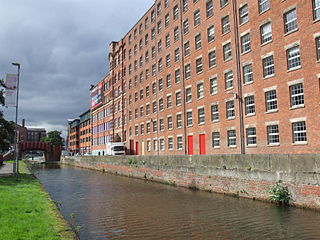
A cotton mill is a building that houses spinning or weaving machinery for the production of yarn or cloth from cotton, an important product during the Industrial Revolution in the development of the factory system.
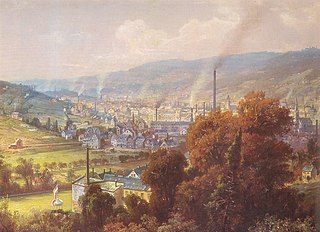
Textile manufacture during the Industrial Revolution in Britain was centred in south Lancashire and the towns on both sides of the Pennines. In Germany it was concentrated in the Wupper Valley, Ruhr Region and Upper Silesia, in Spain it was concentrated in Catalonia while in the United States it was in New England. The main key drivers of the Industrial Revolution were textile manufacturing, iron founding, steam power, oil drilling, the discovery of electricity and its many industrial applications, the telegraph and many others. Railroads, steam boats, the telegraph and other innovations massively increased worker productivity and raised standards of living by greatly reducing time spent during travel, transportation and communications.
Brummagem is the local name for the city of Birmingham, England, and the dialect associated with it. It gave rise to the terms Brum and Brummie.

The factory system is a method of manufacturing using machinery and division of labor. Because of the high capital cost of machinery and factory buildings, factories were typically privately owned by wealthy individuals who employed the operative labor. Use of machinery with the division of labor reduced the required skill level of workers and also increased the output per worker.
Birmingham is one of England's principal industrial centres and has a history of industrial and scientific innovation. It was once known as 'city of a thousand trades' and in 1791, Arthur Young described Birmingham as "the first manufacturing town in the world". Right up until the mid-19th century Birmingham was regarded as the prime industrial urban town in Britain and perhaps the world, the town's rivals were more specific in their trade bases. Mills and foundries across the world were helped along by the advances in steam power and engineering that were taking place in the city. The town offered a vast array of industries and was the world's leading manufacturer of metal ware, although this was by no means the only trade flourishing in the town.
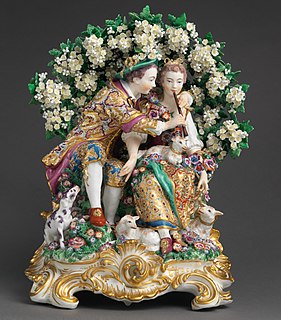
Chelsea porcelain is the porcelain made by the Chelsea porcelain manufactory, the first important porcelain manufactory in England, established around 1743–45, and operating independently until 1770, when it was merged with Derby porcelain. It made soft-paste porcelain throughout its history, though there were several changes in the "body" material and glaze used. Its wares were aimed at a luxury market, and its site in Chelsea, London, was close to the fashionable Ranelagh Gardens pleasure ground, opened in 1742.

The Jewellery Quarter is an area of central Birmingham, UK, in the north-western area of Birmingham City Centre, with a population of around 19,000 people in a 1.07-square-kilometre (264-acre) area.
Events from the year 1761 in Great Britain.
Birmingham in England has developed economically since Mediaeval times.
Joseph Gillott's was an English manufacturing company based in Birmingham founded by Joseph Gillott in 1827 that produced high-quality dip pens. In 1961, Joseph Gillott's was taken over by British Pens Ltd., becoming a brand of it. Pen lines with the Gillott's name were manufactured in the British Pens factory of West Midlands, and currently commercialised by William Mitchell Ltd, one of the brands of the corporation.

Old Bess is an early beam engine built by the partnership of Boulton and Watt. The engine was constructed in 1777 and worked until 1848.

Sir Edward Thomason was a manufacturer and inventor in Birmingham knighted by King William IV.

The Ministry of Industry is a ministry in the Government of Myanmar that produces consumer products such as pharmaceuticals and foodstuffs, textiles, ceramics, paper and chemical products, home utilities and construction materials, assorted types of vehicles, earth-moving equipment, diesel engines, automotive parts, turbines and generators, CNC machines, transformers, agricultural machines, rubber and tires, etc.
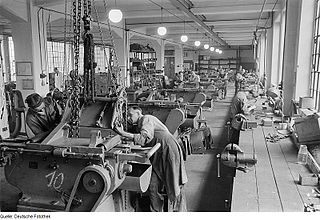
A machine factory is a company, that produces machines. These companies traditionally belong to the heavy industry sector in comparison to a more consumer oriented and less capital intensive light industry. Today many companies make more sophisticated smaller machines, and they belong to the light industry. The economic sector of machine factories is called the machine industry.














